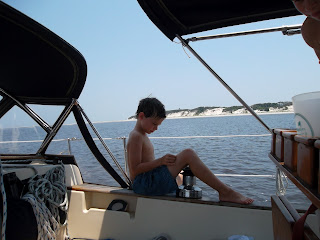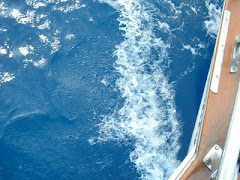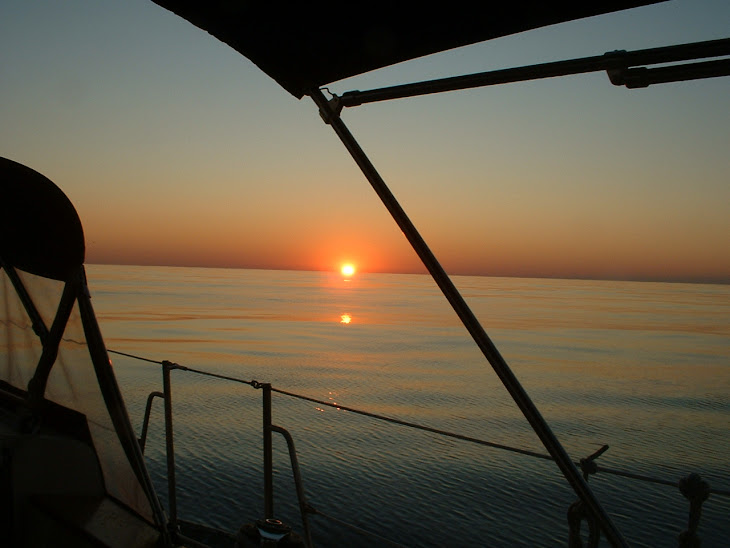It started so well. I would take two and a half weeks and sail down to St. Augustine and back with my girlfriend Gabrielle, her two boys Malo and liam, and of course, Chili. We would do some offshore sailing and some ICW motoring. I wanted to try to get down to St. Augustine quickly and then take some time coming back up to Charleston, with stops at Fernandina Beach, Cumberland Island and River Street in Savannah. Like the title of this post says, though....
The first day was great. We sailed out of Charleston Harbor in the late afternoon on Friday, June 21. We were beating into a 10-12kt wind, slowly tacking our way Southward. We had a nice dinner at sea, and the kids watched a movie in their cabin before drifting off to sleep. Early in the morning the wind died, so we motorsailed. By daybreak we were off of Tybee Roads, Savannah. The water output from the diesel was less than it should have been and I needed rest, so we ducked into the Savannah River and anchored. Although I didn't know it at the time, the engine's waterpump was failing. It was the first of many problems that would arise on this trip.
The next couple of days saw us motoring down the ICW towards St. Augustine. We soon found ourselves completely socked in with nasty weather. It wasn't a typical June rainstorm. No, this was tropical storm Debbie. Great! Well, it wasn't as bad as you might think. We saw winds of up to about 30kts and a lot of rain, but other than that we were just fine. By the time we got down to St. Simons, the waterpump was on its last legs. It had developed a leak at the shaft seal, and would slowly fill the engine bilge with sea water when the seacock for the water intake was open and the engine was running. It was during this time that I discovered my automatic bilge pump wasn't working. The water from the leaky pump would fill the engine bilge and run over into Tranquility's main bilge. The float switch for the automatic bilge pump would cause the pump to turn itself on, but there was a tear in the pump's diaphragm and it wouldn't pump water. Clearly these two issues had to be addressed, so we stopped at Golden Isles Marina to get some work done. While docked there, the weather finally cleared. With a new waterpump and bilge pump, we were ready to continue our trip.
Thursday, June 28 saw us heading offshore from St. Simons. Winds were forecast to be 10-15kts from the SSE, with seas at 2-3 feet. Although the wind direction wasn't great, the windspeed and sea-state was good, so offshore we went. Again we had a great dinner at sea before everyone drifted off to sleep, with me manning the helm. As the night wore on, the winds shifted further south and intensified in speed. The waves also got steeper and closer together. I was seeing winds of 17-20kts, with gusts up to 22-24kts on occasion. I was really close-hauled and clawing to windward. Tranquility would sail along at about five knots, but every third wave or so would rob her of momentum and knock our speed down to two knots. Although she would slowly regain it, we clearly weren't making good enough time, so I fired up the diesel and we began motorsailing at low RPM. This resolved the problem of losing momentum, and Tranquility kept her speed up around five knots again as we clawed our way on down towards St. Augustine.
At 0145 Friday morning, we were 12.2 miles East of Fernandina beach. I tacked Tranquility over onto a starboard tack to head back offshore. We would ride this tack out about 20 miles before making the final tack that would take us into St. Augustine inlet. Windspeed was 20kts, and the seas were three to six feet. I sheeted in and trimmed the headsail, and sat back down at the helm to check the instruments. I suddenly heard a tremendously loud bang and felt the boat shudder violently. I could not believe what I saw. Tranquility's mast had sheared off about three feet above the coachroof and fallen over the port side! Although I was completely stunned and shocked, I instantly turned off the engine to prevent the prop shaft from getting fouled by the rigging which lay all over the house and decks and spilled over into the water. How could this have happened? What would have caused the rig of this strong cruising boat to collapse in 20kts of wind? It turned out to be crevice corrosion on the forward-most starboard side chainplate. It simply broke in half and ripped itself out of the deck, leading to catastrophic rig failure.
So there we were, dismasted and lying beam-to the seas, slowly drifting Northward at two in the morning, 12 miles offshore. I called Sea Tow (with whom I've had a membership for four years), who informed me that since I was dismasted they would consider any assistance they gave me to be a salvage operation, and that my policy didn't cover salvages. WTF?? They couldn't even give me a price for the operation "until our boat gets there in a couple of hours." Thanks for nothing, Sea Tow. With this in mind, I clipped into the jacklines and went on deck with a knife and bolt-cutters and cut my rig away. I lost everything; sails, mast, boom, furlers... everything went to the bottom of the Atlantic. With Tranquility free of that spider web of destroyed rigging, I again fired up the diesel and motored into Fernandina, docking by myself at six in the morning. I immediately collapsed and went to sleep.
It's really beyond my ability to describe to you how I felt then, and how I still feel now about losing the rig. Suffice it to say that it was traumatic and heart-breaking. I will leave it at that. I thank my lucky stars that nobody on board got so much as a scratch.
With the rig gone, all of our plans were changed. The priority became getting the boat home with everyone safe. The next day we began our slow trip home, motoring up the ICW. Two days later, we were anchored behind Blackbeard Island, in Sapelo Sound. A massive thunderstorm blew down on us from the North, with winds at 50kts+, and tremendous amounts of rain and lightening. This was much more disturbing than being dismasted, as the storm raged for four hours. At one point, the violent winds cruelly ripped my solar panels from the top of the bimini and flung them over the side, still attached by their power cable. Because of the wicked rolling of the boat and the weight of the panels, I was unable to save them and had to cut them away, too. As that storm raged on, we were powerless to do anything except pray that Tranquility's anchor would hold. Well, not only did it hold, it didn't budge an inch. I will include a picture of the breadcrumbs that the chartplotter laid during the storm. Tranquility was battered and beaten, but like she has always done in the four years and thousands of miles that I've sailed her, she took care of her passengers. Bless her heart, she is a fantastic cruising boat.
Next day, we slowly continued up the ICW. We eventually made it back to Charleston on July 4th. Two days later, we hauled Tranquility out at Ross Marine to have her rebuilt. Although six weeks have gone by since the dismasting, it still breaks my heart to think about it. The tears I cried for her could fill up a bucket. Despite the hard luck on the trip, we did have moments of fun. There will be memories from this trip, both good and bad for everyone onboard, that will last for a lifetime.









































